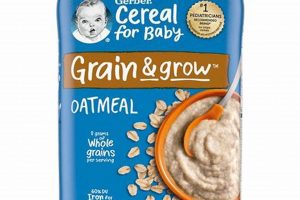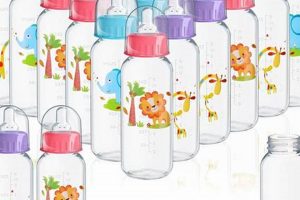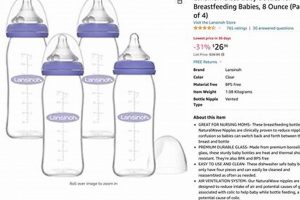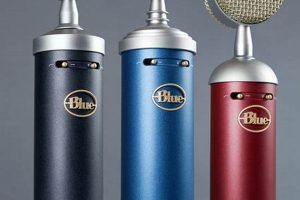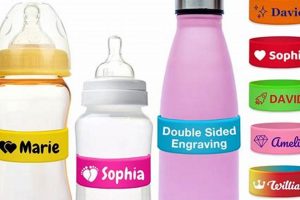Infant feeding devices, specifically those designed to mimic the natural latch and flow of breastfeeding, can provide a viable option for expressed milk or supplemental feeding. These products are characterized by their shape, material, and flow rate, aiming to minimize nipple confusion and support the continuation of direct breastfeeding.
Careful selection of these feeding aids is crucial. Prioritizing designs that promote a wide latch and controlled milk release can assist in preserving established breastfeeding patterns. Historically, advancements in materials and design have focused on replicating the physiological processes of suckling at the breast, recognizing the importance of maintaining infant feeding behaviors.
The subsequent sections will delve into the specific features to consider when choosing appropriate feeding devices, strategies for introducing them effectively, and potential challenges associated with their use, all with the goal of facilitating successful integration with ongoing breastfeeding efforts.
Tips for Selecting and Using Infant Feeding Devices
The following guidance provides essential considerations for introducing artificial nipples to infants who are primarily breastfed, aiming to minimize potential disruptions to breastfeeding patterns.
Tip 1: Prioritize Slow Flow: Opt for a slow-flow artificial nipple designed to regulate milk release, mirroring the flow rate experienced during breastfeeding. This can prevent infants from developing a preference for the faster, less controlled flow often associated with bottles.
Tip 2: Mimic Natural Latch: Select an artificial nipple with a wide base and a gradually tapered shape. This encourages a wide latch, similar to breastfeeding, promoting proper oral motor development and minimizing nipple confusion.
Tip 3: Implement Paced Bottle Feeding: Employ a paced bottle feeding technique. Hold the infant in an upright position, and frequently pause during feeding to allow the infant to regulate intake. This method closely resembles the interactive nature of breastfeeding and helps prevent overfeeding.
Tip 4: Observe Infant Cues: Pay close attention to the infant’s cues of fullness or disinterest. Avoid forcing the infant to finish the bottle, as this can interfere with their natural appetite regulation and potentially impact breastfeeding success.
Tip 5: Introduce Gradually: Introduce the artificial nipple gradually, preferably after breastfeeding is well established (typically around 4-6 weeks of age, or as advised by a lactation consultant). This allows the infant to develop a strong latch and feeding pattern before introducing an alternative.
Tip 6: Clean and Sanitize Properly: Adhere to strict hygiene protocols when cleaning and sanitizing artificial nipples. Improper cleaning can lead to bacterial contamination and potential illness.
Tip 7: Consult a Lactation Professional: If any difficulties arise with bottle feeding or breastfeeding, consult a lactation consultant or healthcare provider. They can provide personalized guidance and address any specific concerns.
Adherence to these guidelines can assist in mitigating potential negative impacts on breastfeeding and promote a successful transition when introducing artificial nipples. Remember that individual infant responses may vary, requiring careful observation and adaptation of feeding strategies.
The subsequent sections will discuss troubleshooting common issues and long-term considerations related to combined breast and bottle feeding.
1. Material
The composition of bottle nipples designed for breastfed infants significantly impacts both safety and the infant’s acceptance of the feeding device. Material choice influences durability, flexibility, and the potential for allergic reactions, thereby necessitating careful consideration.
- Silicone Composition
Silicone, a synthetic polymer, is widely used in the manufacture of infant feeding nipples due to its inert nature. It is resistant to bacterial growth and is generally considered hypoallergenic. Silicone nipples can withstand repeated sterilization without significant degradation, ensuring a prolonged lifespan. However, silicone may be less flexible than latex, potentially affecting latch comfort for some infants.
- Latex Properties
Latex, a natural rubber, offers greater flexibility compared to silicone. This pliability can facilitate an easier latch for some breastfed infants, particularly those accustomed to the soft texture of the breast. However, latex contains proteins that can trigger allergic reactions in sensitive individuals. Furthermore, latex degrades more rapidly than silicone with repeated sterilization, necessitating more frequent replacement.
- BPA/BPS-Free Considerations
Regardless of whether the nipple is made of silicone or latex, it is imperative to ensure that the product is free from Bisphenol A (BPA) and Bisphenol S (BPS). These chemicals, previously used in the production of certain plastics, have been linked to potential endocrine disruption and are therefore prohibited in infant feeding products in many jurisdictions.
- Texture and Surface Treatment
Manufacturers may employ various surface treatments or textures to enhance nipple acceptance. Some nipples feature a matte finish to provide a more secure grip for the infant’s tongue, while others incorporate a textured surface to mimic the feel of the areola. These subtle variations can influence an infant’s preference and overall feeding experience.
Ultimately, the optimal material selection depends on individual infant sensitivity, feeding preferences, and parental priorities regarding durability and potential allergenicity. Careful observation of the infant’s response to different materials is crucial in determining the most suitable option.
2. Flow Rate
Flow rate, the speed at which liquid is dispensed from an artificial nipple, is a critical factor in the context of artificial nipples intended for infants accustomed to breastfeeding. An inappropriate flow rate can disrupt established breastfeeding patterns, potentially leading to nipple confusion or a preference for bottle feeding.
- Slower Flow Mimicry
Artificial nipples designed for breastfed infants often feature slower flow rates to replicate the natural milk ejection process at the breast. Breastfeeding requires active suckling and coordination from the infant to elicit milk release. A bottle nipple with a similarly slow flow forces the infant to work for their milk, preventing passive feeding and reducing the risk of overfeeding. Examples include “slow flow” or “preemie” nipples specifically designed to restrict milk release. This mimicry aims to minimize preference of the faster flow of the bottle.
- Nipple Confusion and Preference
A bottle nipple with a significantly faster flow rate than the breast can lead to what is commonly known as nipple confusion. The infant may become accustomed to the ease of obtaining milk from the bottle, resulting in frustration or refusal to breastfeed. The infant can quickly develop a preference for the bottle. This issue underscores the importance of selecting a bottle nipple with a flow rate closely aligned with the infant’s natural suckling ability and breast milk flow.
- Impact on Infant Oral Motor Development
The flow rate of an artificial nipple influences the development of the infant’s oral motor skills. Breastfeeding encourages a wide, deep latch and rhythmic suckling pattern. Bottle nipples with excessively fast flow rates may bypass these essential developmental processes, potentially impacting the infant’s ability to effectively extract milk from the breast in the long term, creating issues for future breastfeeding.
- Strategies for Flow Rate Selection
When choosing bottle nipples for breastfed babies, healthcare professionals recommend starting with the slowest available flow rate. Observe the infant carefully during feeding, noting any signs of frustration or difficulty. If the infant struggles to obtain milk, a slightly faster flow rate may be considered, but gradual adjustments are critical to avoid overwhelming the infant and disrupting breastfeeding.
Careful consideration of flow rate is paramount when supplementing breastfed infants with bottle feedings. Selection of a flow rate that closely resembles the breast milk ejection pattern, combined with attentive observation of the infant’s feeding cues, can contribute to a more seamless transition between breast and bottle, supporting the continuation of breastfeeding.
3. Ventilation
Ventilation systems integrated into artificial nipples serve a crucial function in mitigating negative pressure buildup within the bottle during infant feeding. This pressure imbalance can cause nipple collapse, interrupt feeding, and potentially contribute to infant discomfort due to swallowed air. The connection between ventilation and artificial nipples designed for breastfed infants is particularly significant because these infants are accustomed to the natural vacuum created during breastfeeding, a process where airflow regulation occurs differently. The absence of proper ventilation in bottle nipples can therefore exacerbate issues like colic and gas, potentially leading to feeding aversion.
Effective ventilation mechanisms, often involving small valves or channels, allow air to enter the bottle as the infant sucks, equalizing pressure and maintaining a consistent milk flow. Various designs exist, from single-vent systems to more complex multi-vent configurations. The efficacy of each design can vary depending on the infant’s sucking strength and feeding style. Real-world examples include observing a reduced frequency of pauses during feeding to release pressure and decreased reports of gas and fussiness after feeding when using properly ventilated nipples. This understanding is practically significant for parents seeking to minimize feeding-related discomfort in their infants.
In summary, ventilation in bottle nipples for breastfed babies is an essential design feature impacting infant comfort and feeding efficiency. It works to counteract negative pressure, thereby reducing the risk of nipple collapse and air ingestion. While various ventilation designs exist, the ultimate goal remains consistent: to provide a feeding experience that closely mimics the natural dynamics of breastfeeding and minimizes common issues like colic. The challenge lies in selecting a system that is effective for the individual infant’s needs and feeding style, promoting a smoother transition between breast and bottle feeding.
4. Shape
The morphology of an artificial nipple exerts a profound influence on its compatibility with breastfeeding. The geometry of the nipple dictates the infant’s latch, sucking mechanism, and overall feeding experience, directly impacting the potential for nipple confusion and breastfeeding cessation.
- Wide Base Mimicry
Artificial nipples with a wide base emulate the areolar region of the breast, encouraging the infant to open their mouth widely and latch deeply. This promotes proper oral motor development and reduces the risk of nipple pain for the breastfeeding parent. Conversely, narrow-based nipples may lead to a shallow latch, potentially causing discomfort and inefficient milk transfer. For example, wide-based nipples often allow more of the nipple to fill the babys mouth creating a seal for suction like breastfeeding.
- Tapered Tip Design
The contour of the nipple tip affects the flow of milk and the infant’s ability to control the feeding process. A gradually tapered tip, as opposed to a blunt or bulbous shape, more closely resembles the natural nipple and allows for a more controlled milk release. Abrupt changes in shape can disrupt the infant’s sucking rhythm and lead to gulping or choking. The tip is also shaped to be flat or rounded to fit the roof of the babys mouth.
- Nipple Length and Protrusion
The length and degree of protrusion of the artificial nipple influence the infant’s tongue positioning and the depth of the latch. A nipple that is too short may not adequately stimulate the infant’s suck reflex, while a nipple that is too long can cause gagging or discomfort. Optimal length and protrusion vary depending on the infant’s age and oral anatomy. If its too long, it can reach the babys throat causing discomfort.
- Orthodontic Considerations
Some artificial nipples are designed with an “orthodontic” shape, featuring a flattened side intended to minimize pressure on the developing palate and promote proper tooth alignment. While the efficacy of orthodontic nipples remains a subject of ongoing research, they represent an effort to address potential long-term oral health concerns associated with prolonged bottle feeding.
In essence, the design of artificial nipples used to supplement breastfed infants should prioritize features that promote a natural latch, controlled milk flow, and optimal oral motor development. Careful attention to these morphological considerations can help to minimize the risk of nipple confusion and support the continuation of breastfeeding. Many manufacturers create artificial nipples to mimic the mothers natural nipples and areola as a guide for shape.
5. Cleanliness
Maintaining meticulous hygiene of artificial nipples is paramount when supplementing breastfed infants. Residual milk provides a breeding ground for bacteria, potentially leading to gastrointestinal distress and other health complications, thereby underscoring the critical nature of thorough cleaning and sterilization practices.
- Immediate Post-Feeding Rinse
Prompt rinsing of artificial nipples with warm water directly after each feeding is essential. This removes the majority of milk residue, preventing it from drying and hardening, which can make subsequent cleaning more difficult. Delays in rinsing increase the likelihood of bacterial proliferation.
- Thorough Cleaning Protocol
Effective cleaning necessitates disassembling the nipple from the bottle and washing all components with hot, soapy water. A dedicated bottle brush should be used to scrub the interior and exterior surfaces of the nipple, paying particular attention to crevices where milk can accumulate. Liquid dish soap that is specifically formulated for baby bottles should be used.
- Sterilization Methods
Sterilization eliminates harmful bacteria that may persist even after thorough washing. Acceptable sterilization methods include boiling the nipples in water for five minutes, using a steam sterilizer, or employing sterilizing tablets or solutions. Strict adherence to manufacturer guidelines for each method is crucial for ensuring effective sterilization.
- Storage Considerations
After cleaning and sterilizing, artificial nipples should be stored in a clean, dry, and covered container. This protects them from environmental contamination and prevents the reintroduction of bacteria. Damp environments promote bacterial growth, therefore complete drying before storage is essential. Sterilized nipples should be only handled with clean hands.
The aforementioned facets of cleanliness are intrinsically linked to the health and well-being of breastfed infants receiving supplemental bottle feedings. Inadequate hygiene practices can negate the benefits of breastfeeding and expose the infant to unnecessary health risks. Parents and caregivers should prioritize these protocols to ensure the safety and efficacy of artificial nipple use. Regular replacement of the nipples should also be followed.
6. Size
The dimensions of artificial nipples used for breastfed infants represent a critical consideration, impacting latch efficacy, feeding volume control, and overall acceptance. Appropriate sizing aligns with the infant’s oral development and feeding capabilities, influencing the success of supplemental bottle feeding.
- Age-Based Sizing Guidelines
Manufacturers typically provide size recommendations based on infant age ranges (e.g., 0-3 months, 3-6 months, 6+ months). These guidelines reflect the average growth in oral cavity size and sucking strength. However, individual variations exist, necessitating careful observation of the infant’s feeding behavior to determine the optimal size. For example, a premature infant may require a smaller nipple size than a full-term infant of the same chronological age.
- Impact on Milk Flow Regulation
Nipple size influences the rate of milk delivery. A larger nipple aperture generally results in a faster flow rate, which may overwhelm a younger infant or disrupt established breastfeeding patterns. Conversely, a nipple that is too small may require excessive sucking effort, leading to frustration and fatigue. Observing the infant’s ability to manage the flow without gulping or choking is crucial in assessing size appropriateness.
- Influence on Latch and Oral Motor Development
The diameter and length of the nipple affect the infant’s latch and oral motor engagement. A nipple that is too wide may be difficult for the infant to latch onto effectively, while a nipple that is too long can trigger the gag reflex. Proper sizing encourages a deep, comfortable latch and supports the development of coordinated sucking and swallowing skills. The size encourages or disrupts the seal formed around the nipple.
- Considerations for Transitioning Sizes
As the infant grows, transitioning to a larger nipple size may be necessary to accommodate increased milk intake and sucking strength. Signs that indicate a need for a larger size include prolonged feeding times, frustration at the bottle, or a noticeable decrease in milk consumption. Gradual size increases, coupled with careful monitoring of the infant’s response, are recommended.
Therefore, while age-based guidelines offer a starting point, the ideal artificial nipple size is ultimately determined by the individual infant’s developmental stage, feeding capacity, and latch mechanics. Meticulous observation and adaptation are essential for ensuring a comfortable and effective bottle-feeding experience that supports, rather than hinders, continued breastfeeding.
7. Acceptance
Infant acceptance of an artificial nipple is a pivotal determinant of successful supplemental feeding for breastfed babies. The infant’s willingness to latch onto and effectively suckle from the artificial nipple directly impacts the ease with which supplemental feedings can be integrated, influencing the continuation of breastfeeding.
- Material Texture and Preference
The tactile properties of the nipple material significantly affect infant acceptance. Some infants exhibit a preference for the softer feel of latex, while others readily accept silicone. Previous exposure to pacifiers made of a particular material can influence this preference. Aversion to a specific texture may manifest as refusal to latch, fussiness during feeding, or inefficient sucking.
- Nipple Shape and Latch Acquisition
The geometry of the artificial nipple impacts the ease with which the infant can achieve a secure latch. A shape that closely mimics the maternal nipple during breastfeeding often facilitates better acceptance. If the shape is unfamiliar or requires a significantly different latching technique, the infant may resist the artificial nipple, leading to frustration and feeding difficulties. A wide base, for example, may encourage a similar latch to the breast.
- Flow Rate and Suckling Effort
The speed at which milk is delivered from the artificial nipple influences the infant’s willingness to feed. A flow rate that is too rapid can overwhelm the infant, causing gagging or choking, while a flow rate that is too slow can lead to frustration and decreased interest in feeding. Matching the flow rate to the infant’s sucking strength and developmental stage is crucial for promoting acceptance.
- Temperature and Sensory Perception
The temperature of the milk and the artificial nipple itself can influence infant acceptance. Infants may exhibit a preference for milk that is slightly warm, similar to the temperature of breast milk. A cold or room-temperature nipple may be rejected. Additionally, the presence of any unfamiliar smells or tastes can negatively impact acceptance; thus, thorough cleaning is crucial.
Ultimately, successful introduction of an artificial nipple to a breastfed infant hinges on careful consideration of individual preferences and sensitivities. Observation of the infant’s response to various materials, shapes, flow rates, and temperatures is essential for identifying the optimal combination that promotes acceptance and supports the continuation of breastfeeding. Failure to achieve acceptance can result in feeding difficulties, decreased milk intake, and potential disruption of the breastfeeding relationship.
Frequently Asked Questions
The following addresses common inquiries concerning the selection and use of artificial nipples intended for infants primarily sustained through breastfeeding. The information presented aims to clarify best practices and mitigate potential complications.
Question 1: What constitutes “nipple confusion” and how does it relate to artificial nipple use?
Nipple confusion denotes an infant’s altered suckling technique resulting from inconsistent or conflicting feeding methods. It manifests as difficulty latching onto the breast, inefficient milk extraction, or a preference for the more readily available flow from a bottle. Minimizing disparities between the breast and artificial nipple reduces the incidence of this issue.
Question 2: Are specific artificial nipple materials superior for breastfed infants?
Both silicone and latex nipples present advantages and disadvantages. Silicone offers durability and hypoallergenic properties, while latex provides greater flexibility. Material selection should align with the infant’s tolerance and any known allergies. BPA-free designations are mandatory regardless of material.
Question 3: How does artificial nipple flow rate impact breastfeeding?
An excessively rapid flow rate can lead to overfeeding, reduced suckling effort, and potential breast refusal. Artificial nipples designed for breastfed infants should possess a slow flow rate, mimicking the natural milk ejection reflex and promoting active suckling.
Question 4: What role does proper artificial nipple hygiene play in infant health?
Inadequate cleaning of artificial nipples facilitates bacterial proliferation, elevating the risk of gastrointestinal infections. Rigorous cleaning and sterilization protocols are imperative to safeguard infant health. Regular replacement of nipples is also recommended.
Question 5: Can artificial nipple shape influence breastfeeding outcomes?
Artificial nipples with a wide base and tapered tip encourage a natural latch, minimizing the risk of nipple confusion. Orthodontic designs may offer long-term oral health benefits, although conclusive evidence remains limited.
Question 6: When is the optimal time to introduce an artificial nipple to a breastfed infant?
Introduction should occur after breastfeeding is well established, typically around 4-6 weeks of age, or as advised by a lactation consultant. Premature introduction can disrupt the infant’s developing suckling patterns and undermine breastfeeding success.
Prudent selection and utilization of artificial nipples, informed by a comprehensive understanding of the aforementioned considerations, can facilitate successful supplemental feeding without compromising the benefits of breastfeeding.
The subsequent section will explore potential challenges associated with combined breast and bottle feeding, along with effective troubleshooting strategies.
Conclusion
The preceding discourse has illuminated the multifaceted considerations surrounding bottle nipples for breastfed babies. From material composition and flow rate calibration to shape conformity and meticulous hygiene, each element contributes significantly to the overall success of combined feeding strategies. Prioritizing designs that mimic natural breastfeeding dynamics remains paramount.
Optimal selection and utilization of these feeding implements necessitate informed decision-making, continuous observation, and, when appropriate, consultation with lactation professionals. Consistent adherence to evidence-based guidelines is critical for safeguarding infant well-being and fostering a harmonious breastfeeding journey.


